In the last blog post we looked at virtual classroom types, uses and its application for language online learning at inlingua centers. In this post we are going to focus on some of the more technical details of using the inlingua virtual classroom.
Getting Started
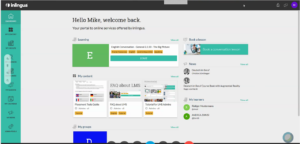 Once a course has been allocated by a center administrator to a learner, the learner will receive a link by email to the lessons timetabled. Lessons are accessed through my.inlingua.com, where trainers and learners will find their online learning courses and lessons and from where they can join lessons easily. The learner can log in to a lesson at the time allocated or a few minutes before if the appointed trainer has already opened the lesson. New learners may need to download software from inlingua-WebEx to set up the virtual classroom, initially. Alternatively, the virtual classroom provided by Zoom can be used. The main features are similar.
Once a course has been allocated by a center administrator to a learner, the learner will receive a link by email to the lessons timetabled. Lessons are accessed through my.inlingua.com, where trainers and learners will find their online learning courses and lessons and from where they can join lessons easily. The learner can log in to a lesson at the time allocated or a few minutes before if the appointed trainer has already opened the lesson. New learners may need to download software from inlingua-WebEx to set up the virtual classroom, initially. Alternatively, the virtual classroom provided by Zoom can be used. The main features are similar.
The inlingua-WebEx Classroom from the Learner’s Perspective
The main viewing panel
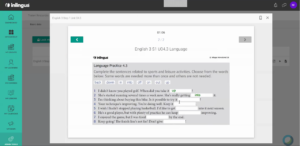 Although access to some functions may vary as updates are applied, the features remain more-or-less the same. The main viewing panel will display the lesson contents and will be changed by the trainer as the lesson progresses. This enables the learner or learners to see the same pages, exercises or resources as the trainer throughout the lesson. The main contents of the lesson are taken from the printed Course Book. For standard online learning courses, it is advisable that the learners also have the Course Book in printed form or on a tablet as a flex-e-book. The flex-e-book can also be used for tailored courses.
Although access to some functions may vary as updates are applied, the features remain more-or-less the same. The main viewing panel will display the lesson contents and will be changed by the trainer as the lesson progresses. This enables the learner or learners to see the same pages, exercises or resources as the trainer throughout the lesson. The main contents of the lesson are taken from the printed Course Book. For standard online learning courses, it is advisable that the learners also have the Course Book in printed form or on a tablet as a flex-e-book. The flex-e-book can also be used for tailored courses.
Webcam view
It is possible to view the participant’s webcams in various modes. It is advisable to switch off the webcams during the lesson, however, as this can slow down the connection.
Annotating
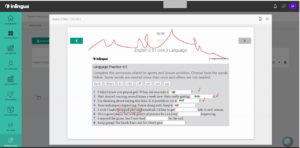
The trainer and the learners can use an annotating tool to write or draw on the screen. Learner access to the annotation tool is controlled by the trainer but can also be requested by the learner.
Whiteboard
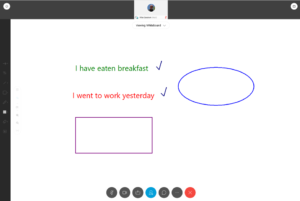
There is a whiteboard function where the trainer and learners can write, draw or upload additional content. Content from other sources such as video can be displayed by the trainer if required. Learners can share content at the discretion of the trainer.
The chatroom
A side-panel can be used as a chatroom during the online learning session. Trainers and learners can select the recipient of the message.
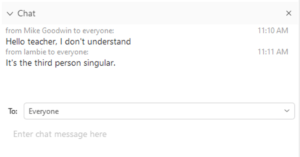
Hands-up request icon
![]() In the side-panel there is a list of participants. Each learner can see a hand icon by her/his name. This can be used to ask a question to the trainer e.g. for clarification.
In the side-panel there is a list of participants. Each learner can see a hand icon by her/his name. This can be used to ask a question to the trainer e.g. for clarification.
The trainer will see the request pop up by the learner’s name in the trainer’s side panel.
Other features
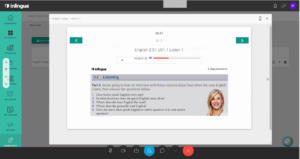 Audio tracks from the course can be played by the trainer. Classes using Zoom as an alternative to inlingua-WebEx can also feature learners being put into break-out rooms for pairwork or work in small groups.
Audio tracks from the course can be played by the trainer. Classes using Zoom as an alternative to inlingua-WebEx can also feature learners being put into break-out rooms for pairwork or work in small groups.
Conversation classes
Virtual conversation classes work on the same principle, but the trainer is sharing additional content specifically developed for conversation. The trainers on the conversation courses are provided from inlingua International, so will not be the same trainer as in the main course.
The inlingua-WebEx Classroom from the Trainer’s Perspective
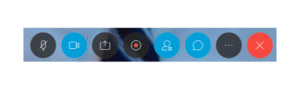 The main features are the same as the learner’s perspective. The trainer can assign privileges to learners such as allowing them to share content or annotate on the screen.
The main features are the same as the learner’s perspective. The trainer can assign privileges to learners such as allowing them to share content or annotate on the screen.
Essentially, the trainer is sharing her/his screen which is connected to the virtual classroom resources for that lesson. For each unit and section (key point) of our main material there are trainer resources available which they can use during the lesson. The trainer can move a ball icon in the participants’ list to allow a learner to take over the lesson and share her/his screen with all the participants and the trainer.
Reporting
At the end of the lesson, learners can choose a rating for the lesson. Trainers have to write reports for administration purposes.
To register a center for virtual classroom access contact Peter König.
For training in the use of the virtual classroom contact Mike Goodwin.
To register as a learner for a virtual classroom course contact your local inlingua center.
Next blog: Tailoring the Lesson with the flex-e-book.